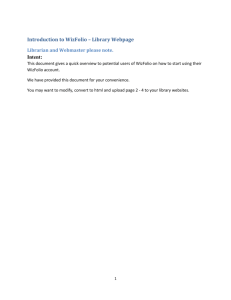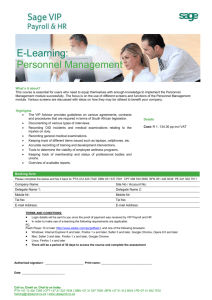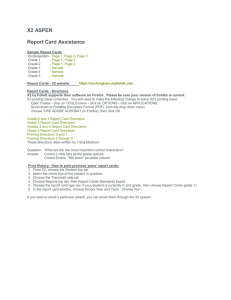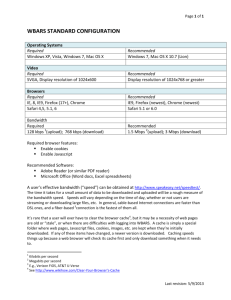the latest open source software available
advertisement
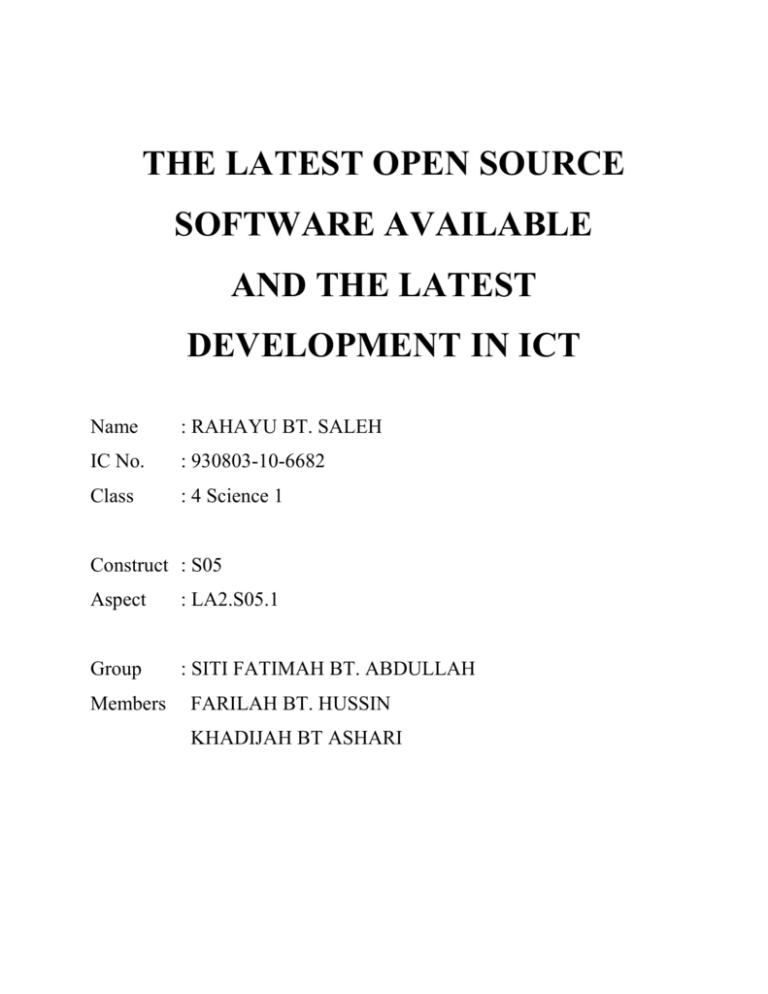
THE LATEST OPEN SOURCE SOFTWARE AVAILABLE AND THE LATEST DEVELOPMENT IN ICT Name : RAHAYU BT. SALEH IC No. : 930803-10-6682 Class : 4 Science 1 Construct : S05 Aspect : LA2.S05.1 Group : SITI FATIMAH BT. ABDULLAH Members FARILAH BT. HUSSIN KHADIJAH BT ASHARI INTRODUCTION Open source means a relating to source code that is available to the public. Open source software (OSS) is defined as a computer software for which the source code and certain other rights normally reserved for copyright holders are provided under a software license that meets the Open Source Definition or that is in the public domain. Open source hardware refers to computer and electronic hardware that is designed in the same fashion as free and open source software (FOSS). Software is a program which consists of a set of instructions that tells the computer how to perform a specific operation. Software is often divided into application software (programs that do work users are directly interested in) and system software (which includes operating systems and any program that supports application software). Hardware is the physical aspect of computers, telecommunications, and other devices. Hardware includes not only the computer proper but also the cables, connectors, power supply units, and peripheral devices such as the keyboard, mouse, audio speakers, and printers. Hardware is sometimes used as a term collectively describing the physical aspects of telephony and telecommunications network infrastructure. THE LATEST OPEN SOURCE OPERATING SYSTEM (OS) Open source operating system can be defined as a set of programs that coordinates all the activities among the computer hardware devices which relates to a source code that is available to the public. Examples of open source operating system: Linux (commonly pronounced /ˈlɪnəks/) is a generic term referring to Unix-like computer operating systems based on the Linux kernel. Their development is one of the most prominent examples of free and open source software collaboration; typically all the underlying source code can be used, freely modified, and redistributed by anyone under the terms of the GNU GPL and other free licenses. Tux (Linux’s Mascot) GNOME (pronounced /ɡəˈnoʊm/)[1] is a desktop environment—a graphical user interface which runs on top of a computer operating system—composed entirely of free software. It is an international project that includes creating software development frameworks, selecting application software for the desktop, and working on the programs which manage application launching, file handling, and window and task management. GNOME is part of the GNU Project and can be used with various Unix-like operating systems, most notably those built on top of the Linux kernel and the GNU userland, and as part of Java Desktop System in Solaris. The name originally stood for GNU Network Object Model Environment. THE LATEST OPEN SOURCE APPLICATION SOFTWARE Open source application software is a computer program or a suite of computer programs that performs a particular function for the user which relates to a source code that is available to the public. Examples of open source application software: Google Chrome is a web browser released by Google which uses the WebKit layout engine and application framework. It was first released as a beta version for Microsoft Windows on 2 September 2008, and the public stable release was on 11 December 2008. The name is derived from the graphical user interface frame, or "chrome", of web browsers. In May 2009, Chrome was the fourth most widely used browser, with 1.80% of worldwide usage share of web browsers. Development versions of Chrome for Linux and Mac OS X were released in June 2009. Google Chrome Firefox Mozilla Firefox is a free and open source web browser descended from the Mozilla Application Suite and managed by Mozilla Corporation. Firefox had 22.47% of the recorded usage share of web browsers as of July 2009, making it the second most popular browser in terms of current use worldwide, after Microsoft's Internet Explorer. To display web pages, Firefox uses the Gecko layout engine, which implements most current web standards in addition to several features which are intended to anticipate likely additions to the standards. Latest Firefox features include tabbed browsing, spell checking, incremental find, live bookmarking, a download manager, private browsing, location-aware browsing based exclusively on a Google service and an integrated search system that uses Google by default in most localizations. Functions can be added through add-ons, created by third-party developers, of which there is a wide selection, a feature that has attracted many of Firefox's users. Firefox runs on various versions of Mac OS X, Microsoft Windows, Linux, and many other Unix-like operating systems. Firefox's source code is free software, released under a tri-license GNU GPL/GNU LGPL/MPL. Official versions are distributed under the terms of a proprietary EULA. THE LATEST DEVELOPMENT IN ICT Hardware The new Dell G2210 and G2410 monitors are designed for energy and cost savings with features like PowerNap and Dynamic Dimming... and they're made and packaged to help minimize environmental impact. The G2210 22" offers: High efficiency for minimal power consumption Made with environmentally preferable materials Designed and packaged to help reduce environmental impact. The DellTM E773c was designed to accommodate a wide variety of users ranging from home and small offices to large corporate environments. Optimal resolution of 1024 x 768 pixels at a refresh rate of 75 Hz 15.98" viewable image size with 0.27 mm Phosphor diagonal pitch Anti-glare and anti-static coating on the faceplate Bright and sharp images for all applications Software Windows 98 (codenamed Memphis) is a graphical operating system released on 25 June 1998 by Microsoft and the successor to Windows 95. Like its predecessor, it is a hybrid 16-bit/32-bit monolithic product based on MS-DOS. Windows 98 was succeeded by Windows Me on 14 September 2000. Windows 7 (formerly codenamed Blackcomb and Vienna) is an upcoming version of Microsoft Windows, a series of operating systems produced by Microsoft for use on personal computers, including home and business desktops, laptops, tablet PCs and media center PCs. Windows 7 was released to manufacturing on July 22, 2009, with general retail availability set for October 22, 2009, less than three years after the release of its predecessor, Windows Vista. Windows 7 is intended to be a more focused, incremental upgrade to the Windows line, with the goal of being fully compatible with applications and hardware with which Windows Vista is already compatible. PERVASIVE COMPUTING Meaning of pervasive computing Pervasive computing provides convenient access to relevant information and applications through a new class of ubiquitous, intelligent appliances that have the ability to easily function when and where needed. It is also known as ubiquitous computing. Examples: One of the earliest ubiquitous systems was artist Natalie Jeremijenko's "Live Wire", also known as "Dangling String," installed at Xerox PARC during Mark Weiser's time there. This was a piece of string attached to a stepper motor and controlled by a LAN connection; network activity caused the string to twitch, yielding a peripherally noticeable indication of traffic. Weiser called this an example of calm technology. Nabaztag(Armenian for "rabbit") is a Wi-Fi enabled ambient electronic device in the shape of a rabbit, invented by Rafi Haladjian and Olivier Mével, and manufactured by Violet. Nabaztag is a "smart object" comparable to those manufactured by Ambient Devices; it can connect to the Internet (for example to download weather forecasts, read its owner's email, etc). It is also fully customizable and programmable. CONCLUSION In conclusion, information and communication has been developed through technology over the past thousands of years. And there is no limit to development of information, communication and technology today. ICT today has definitely helped to improve our lives and make things all very convenient. That is why, we should appreciate the people who started technology and expand their work even more to help improve living in this modern age. Reference: www.wikipedia.org/wiki http://www.computerworlduk.com/technology/operating-systems/ http://www.isoc.org/inet2000/cdproceedings/3a/3a_1.htm http://images.search.yahoo.com/images http://www.centos.org/

